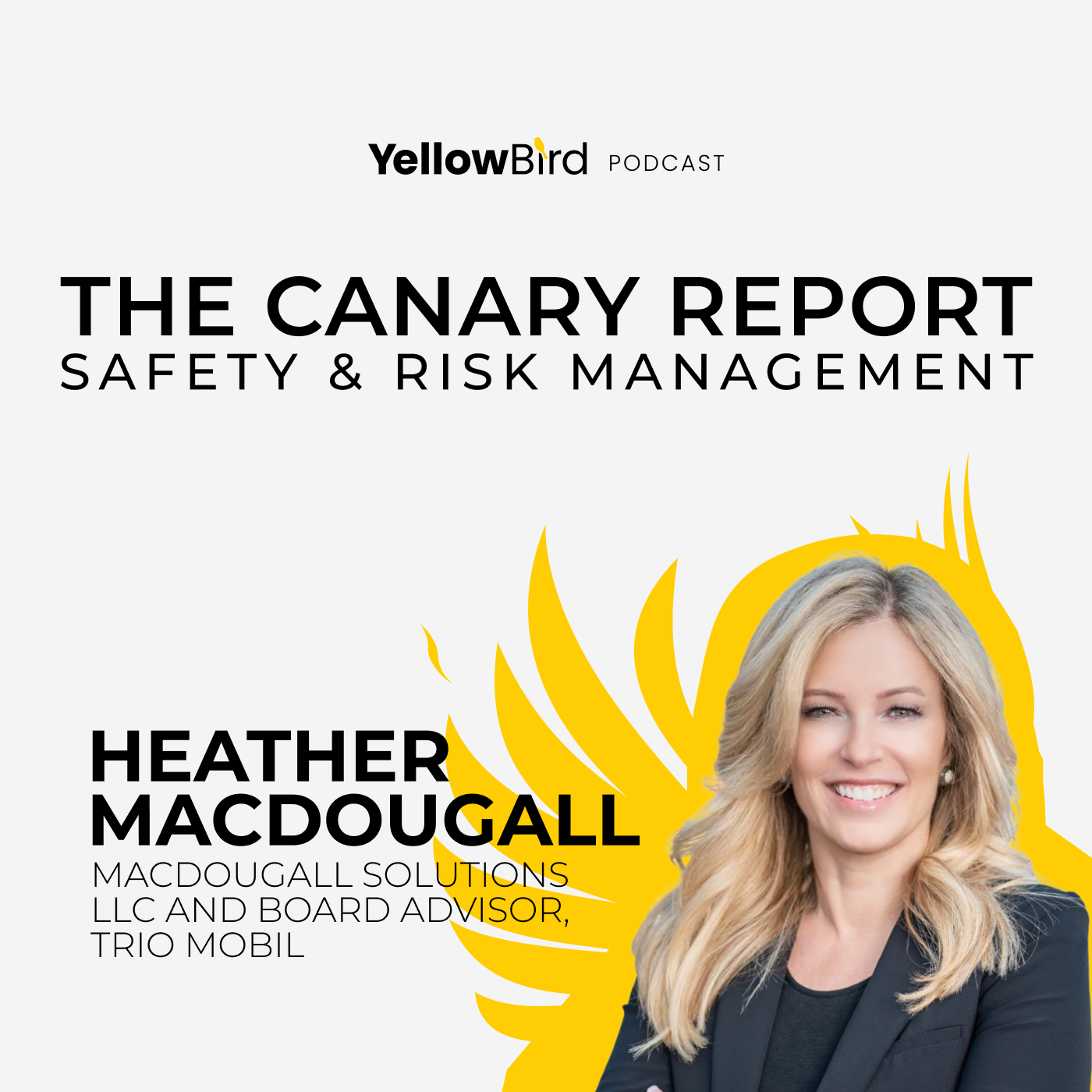Safety Has a Seat at the Table: Lessons from Amazon’s Former Chief Safety Officer
Safety isn’t just about preventing incidents. It’s about building trust, making smarter decisions, and driving real performance.

That’s the message Heather MacDougall brings to the table in her conversation with Michael Zalle on The Canary Report.
With over three decades of experience, from serving as Chair of the Occupational Safety and Health Review Commission (OSHRC) to leading safety for over 1.6 million employees as Chief Safety Officer at Amazon, Heather has seen what works, what doesn’t, and what has to change if we want to make meaningful progress in enterprise safety.
Here’s what stood out from this conversation about what it really takes to lead safety at scale.
Giving Safety a Real Seat at the Table
Too often, safety gets treated like a support function, brought in late, or left out entirely, when major business decisions are being made.
Heather challenges that dynamic with her “four-legged stool” model: safety should sit at the same table as finance, HR, and operations. At Amazon, that meant safety had a voice in every major strategic decision. But it didn’t happen by accident.
It took building clear, shared metrics. It took creating cross-functional meeting cadences. And it took tools like the “six-page white paper,” a structured decision-making framework that pushed teams to stay focused, think critically, and align on goals.
The takeaway? If you want safety to matter, you have to embed it in the actual structure of how your organization works, not just bolt it on at the end.
Smarter Decisions, Faster: The Two-Way Door Framework
One of the most practical ideas in this episode is the decision-making framework Amazon uses to distinguish between “one-way” and “two-way” doors.
- One-way doors are irreversible choices. They need careful analysis, input, and time.
- Two-way doors are reversible. You can try something, learn, and adjust quickly.
Heather explains how this mindset helped safety teams avoid getting bogged down in analysis paralysis. It empowered them to move fast when they could, but also to know when to slow down and dig deep.
In a safety culture, this is gold. Not every hazard requires a task force. And not every change should be slow. The key is knowing which is which and making that call up front.
Compliance is the Floor, Not the Ceiling
Heather is clear: compliance is essential, but it’s just the beginning.
Too many safety programs stop at the minimum requirements. They aim to avoid citations, not to drive progress. That’s a huge missed opportunity.
The best organizations? They treat compliance like the baseline. From there, they build systems that focus on continuous improvement, data-informed risk reduction, and strategic alignment with business goals.
Heather shares examples of how leading companies are using AI, IoT, and data analytics to go beyond traditional metrics and tackle persistent safety challenges, like forklift operations and other high-risk tasks. These tools aren’t silver bullets. But when combined with a human-centered approach, they unlock smarter, more proactive systems.
Reframing Regulation: From Enforcer to Partner
Heather’s background in Washington gives her a unique lens on how regulation works, and where it falls short. Her take?
Agencies like OSHA need to evolve. Instead of relying solely on traditional lagging indicators like TRIR and focusing purely on enforcement, regulators should explore ways to partner with businesses. That means embracing leading indicators, recognizing innovation, and rewarding companies that go beyond the basics.
Heather calls for more public-private partnerships, the kind that bring together government, industry, and labor to co-create solutions that actually work in today’s complex environments.
When regulators become collaborators, everyone wins. And more importantly, more people stay safe.
There's No Silver Bullet; Just Real Problem-Solving
One of the most grounded moments in the conversation comes when Heather reflects on the mindset that makes great safety professionals.
“We love solving problems,” she says. “There’s no silver bullet. It’s never just one thing.”
That’s the reality of this work. Whether you’re in the field or in the boardroom, safety leadership is about layered solutions, constant iteration, and deep collaboration.
It’s not flashy. It’s not fast. But it’s meaningful. And when done right, it makes an impact that extends far beyond injury prevention. It builds trust. It earns respect. It makes companies better at what they do.
The Human Side of Safety
Heather opens up about what it was like to lead through the chaos of COVID-19, navigating conflicting laws in different jurisdictions, managing employee concerns, and reporting progress to the board. It wasn’t clean or easy. But it was human.
That’s what safety leadership demands. Not just technical knowledge, but the ability to bring people together across disciplines, legal, finance, HR, operations, and make decisions with incomplete information, high stakes, and real consequences.
It’s why safety professionals often become trusted advisors at the highest levels of an organization. And it’s why conversations like this one matter.
Final Takeaway: Lead Like It Matters; Because It Does
If there’s one message to walk away with, it’s this: Safety isn’t a department. It’s a way of thinking. Heather has spent her career pushing organizations to reframe how they see safety, not as a box to check, but as a driver of performance, resilience, and trust. Her work at Amazon and OSHRC shows what’s possible when safety has a real seat at the table.
And in a world that’s only getting more complex, the companies that thrive will be the ones that stop playing defense and start leading safety like it matters.
Because it does.
🎧 Listen to the full episode of The Canary Report featuring Heather MacDougall:
Apple Podcasts:
https://bit.ly/3UjpxGa
Spotify:
https://bit.ly/45nJjW1
YouTube:
https://lnkd.in/gVzZ9huY
👉 Subscribe to The Canary Report for more real talk with safety leaders who are reshaping how we think about risk, leadership, and human performance.

